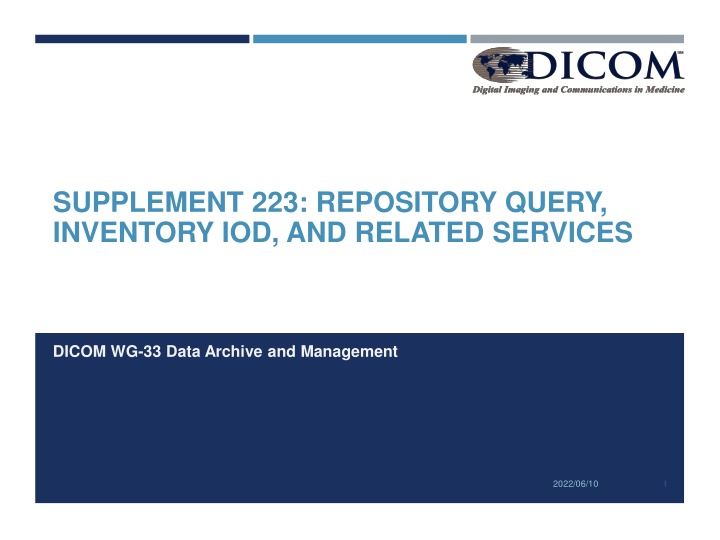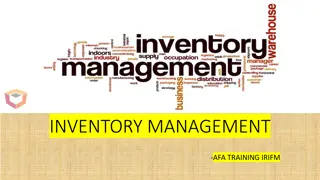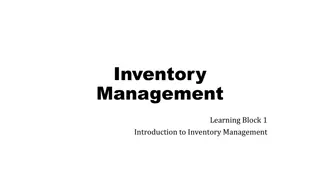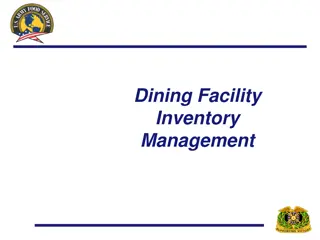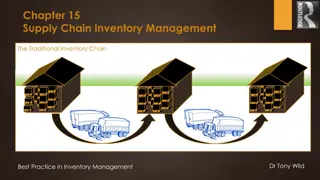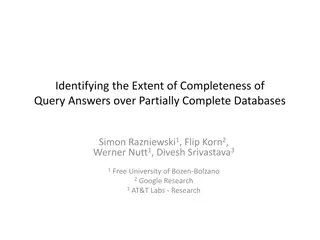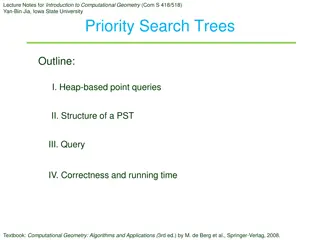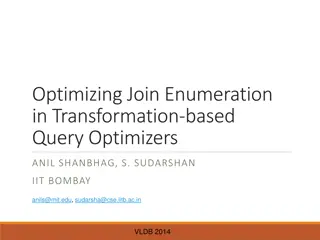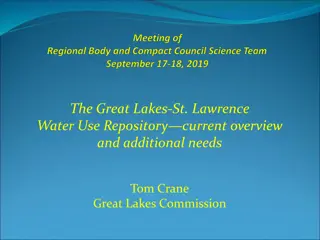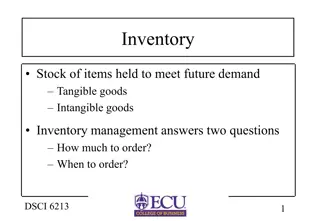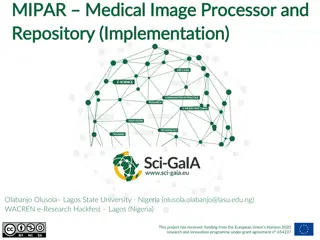SUPPLEMENT 223: REPOSITORY QUERY, INVENTORY IOD, AND RELATED SERVICES
Established in December 2019, WG-33 focuses on data archive and management, with a comprehensive history dating back to its inception. From standardization efforts to addressing PACS migration challenges, the group has made significant progress in defining Inventory IOD and related services. Explore the evolution of WG-33 and its relevance in the context of PACS migration and enterprise-scale data operations.
Download Presentation

Please find below an Image/Link to download the presentation.
The content on the website is provided AS IS for your information and personal use only. It may not be sold, licensed, or shared on other websites without obtaining consent from the author.If you encounter any issues during the download, it is possible that the publisher has removed the file from their server.
You are allowed to download the files provided on this website for personal or commercial use, subject to the condition that they are used lawfully. All files are the property of their respective owners.
The content on the website is provided AS IS for your information and personal use only. It may not be sold, licensed, or shared on other websites without obtaining consent from the author.
E N D
Presentation Transcript
SUPPLEMENT 223: REPOSITORY QUERY, INVENTORY IOD, AND RELATED SERVICES DICOM WG-33 Data Archive and Management 2022/06/10 1
History WG-33 established by DSC December 2019, SIIM as Secretariat In response to Laitek proposal from April 2019 Substantive work began March 2020, with broad user and vendor participation Consensus technical approach for Inventory IOD agreed August 2020 Work Item approved by DSC August 2020 WG-6 approved Draft Supplement for Public Comment April-May 2021 Comment from GE requested equivalent query-based mechanism DSC direction to include query in Sup 223 August 2021 WG-33 and WG-6 consensus for dual approach (IOD and query) WG-6 approved revised Draft Supplement for 2nd Public Comment Nov 2021-Jan 2022 WG-6 approved Letter Ballot April-June 2022 2022/06/10 2
Primary Use Case PACS migration Users typically replace PACS after ~12-15 years, often with change of vendor Became a significant user (PACS administrator) concern in 2010 s Institutional consolidation often requires merge of disparate PACS Replacement/consolidation requires migrating historical data to a new system Digital storage often retained forever Volumes increasing with hi-res, 3D/4D, and multimodality studies Many institutions store > 109 instances with data volumes > 1015B (petabyte) Performance at scale is challenging DICOM Query/Retrieve designed for accessing relatively small number of studies Need mechanisms that account for enterprise-scale data operations 2022/06/10 3
But Sup 223 is not a PACS migration standard PACS migration is a multi-faceted endeavor, some aspects of which can be supported by DICOM standards, and others that cannot Sup 223 addresses one critical need to support migration production of a standardized inventory of the DICOM content of a repository Required to prepare for migration, and to validate completeness of migration Many other processes involved in execution of migration Sup 223 is a standard for Inventory IOD and related services Inventory object and services may also support other use cases 2022/06/10 4
Secondary Use Case Clinical Research and Business Analytics Inventory can be important data source (in conjunction with EMR and image instances) for research and analytics Representation of the PACS database in standard non-proprietary format Can be searched or processed without impacting PACS in clinical operation Transferrable to research IT system (data warehouse) extract in paradigm of Extract/Transform/Load (E/T/L) Inventory may be produced for a specified selection of studies based on modality and/or study or series description De-identification as required in research not in scope of Sup 223 De-ID is part of E/T/L transform , and highly dependent on merge process with other data sources 2022/06/10 5
Secondary Use Case Safety Backup Image access is a patient safety / mission critical resource PACS DBMSs typically have fault tolerant designs E.g., redundant online storage and offline backups But data is in proprietary format and dependent on the DBMS for effective use DBMS becomes single point of failure May become inoperable, e.g., due to license key expiration or malware attack Inventory is a DBMS-independent replica of the critical data content of the PACS database for the managed DICOM SOP Instances If the repository instances are in DICOM File Format and referenced in the inventory, there is a complete alternate path to access the images 2022/06/10 6
Secondary Use Case Quality Control Inventory may be produced for studies missing critical attribute values (optional capability of inventory creator) Patient ID, Accession Number, Study Date Allows proactive correction Comparison data for wellness check (continuous testing) of PACS operation C-FIND result for sample of studies compared to data in previous inventory (e,g., metadata, number of images) C-MOVE retrieve objects compared to direct filesystem access objects Message digest (MAC) computed on objects retrieved through filesystem compared to MAC in previous Inventory 2022/06/10 7
Overview of Sup 223 2022/06/10 8
Two approaches for producing inventory Query-based (synchronous) Persistent Object-based (asynchronous) Extension of classic C-FIND to support return of entire database across multiple query transactions Exchangeable information object that can be processed off-line Creation initiated by repository function or by associated DICOM service Minimal additional requirements for existing software facilitates implementation in deployed systems Managed like other DICOM non- patient objects Both produce Inventory of entire repository (or described subset) in non-proprietary format Hierarchical structure based on DICOM information models 2022/06/10 9 Encoded using DICOM formats and data structures
Repository Query Service 2022/06/10 10
C-FIND Client PACS database Archive Data Store Repository Query obtains a complete inventory in a sequence of query transactions 2022/06/10 11
Query features Repository Query SOP Class is limited extension of Study Root Query SOP Class with semantics of partial results/continuation Three new required Attributes Does not require Extended Negotiation, nor change to any other C-FIND semantics Additional Key Attributes supporting inventory use case are optional Additional Attributes optional for both SCU and SCP, explicitly requested in Query Query Response like all other matching Key Attributes Two new optional Key Attribute matching mechanisms Agreed through Extended Negotiation, like other enhanced matching (fuzzy semantic, combined date time, etc.) 2022/06/10 12
Partial result and continuation SCP and SCU may limit number of query response records returned Each returned record includes a Record Key SCU may send Prior Record Key in next Query SCP resumes responses with next Record Key 2022/06/10 13
Partial result SCP and SCU may limit number of response records returned SCP internal limit (number, duration of processing, time of day, etc.) SCU requested maximum number Purpose 1: allow inventory to be retrieved across multiple Query transactions, allowing management of resources on both SCP and SCU sides Purpose 2: addressing possible network communication failures during long duration synchronous association When limit is reached, SCP sends final message with appropriate status code indicating incomplete response to query New status code B001 Warning (C-FIND Warning added to PS3.7) Similar to C-MOVE B000 Warning when some Instances could not be sent 2022/06/10 14
Record Key Each returned record includes a Record Key Must be requested by SCU (Type R Key Attribute, universal match ONLY) Record Key is opaque (to SCU) binary string of implementation-specific length (VR=OB) Response records ordered by Record Key SCU may send Prior Record Key in next Query Last received Record Key upon receipt of B001 Warning status, or upon abnormal end of network association SCP resumes responses with next Record Key 2022/06/10 15
Record Key characteristics Responses must be ordered by Record Key to allow continuation in subsequent Query Handling of inserted new record keys during sequential set of Queries is implementation-specific Record Key may include other state information for continuation SCP does not need to retain such state information, as it will be returned in next Query Implementation specific key VR=OB allows carrying of as much state information as desired UID is usually not sufficient as Record Key 2022/06/10 16
New Repository Query SOP Class defines behavior Use of Warning Status and Record Key defined in new SOP Class Partial results imperfectly defined for existing C-FIND SOP Classes, and we re not fixing that No resumption behavior in existing C-FIND SOP Classes New capability agreed by basic negotiation of SOP Class 2022/06/10 17
Additional Query features Matching mechanisms and Extended Negotiation Generally available Key Attribute Study Update DateTime Repository Query specific Key Attributes Repository Query control attributes 2022/06/10 18
Multiple Value and Empty Value Matching For attributes with VM > 1, Key Attribute with multiple values matches target attribute if all Key values are present in target Example purpose: find multi-modality studies by matching against Modalities in Study Key Attribute value "" matches target Attribute with no value (or absent) Example purpose: find studies missing date, accession number, patient ID, etc. values for quality assurance New matching capabilities optional, but generally available for all C-FIND Agreed through new Extended Negotiation items (similar to combined date time or fuzzy semantic matching extensions to base matching capabilities) Modification to DA, DT, and TM VRs in PS3.5 to allow " character in Query (similar to allowing for range matching of DA) 2022/06/10 19
Study Update DateTime New attribute for Study Update DateTime DateTime of last update to Study metadata (e.g., Patient, Study or Procedure, Imaging Service Request, or Series Attributes) or to the set of SOP Instances in the Study Defined at Study Level, but not in composite SOP Instances (similar to Number of Study Related Instances (0020,1208) ) Example purpose: find Studies that were added or updated since the previous inventory New optional Key Attribute generally available for all C-FIND Strongly recommended for implementation in all PACS/VNAs 2022/06/10 20
Repository Query specific Key Attributes Further information in description of Inventory IOD Removed from Operational Use, Reason for Removal Code Sequence Supports deprecated objects File Set Access Sequence, File Access Sequence Non-DICOM protocol file access URIs at Study/Series level and Instance level, respectively Metadata Sequence, Updated Metadata Sequence Mechanism to request/return all metadata attributes managed in PACS DB, or all updated attributes not propagated into stored instance Support for one or both attributes required if Non-DICOM protocol file access supported Universal match on SQ allows SCP to populate Item as appropriate without SCU needing to enumerate Attributes 2022/06/10 21
Repository Query control attributes Prior Record Key, Maximum Number of Records (see above on Partial result and continuation) Control attributes similar to Specific Character Set, Timezone Offset From UTC Considered alternative of Extended Negotiation Undesirable due to more complex implementation Needs to be fundamental to SOP Class (not a negotiable option) 2022/06/10 22
Inventory IOD 2022/06/10 23
Client PACS database Archive Data Store Inventory is representation of PACS DB provided to client Inventory Equivalent of complete set of Repository Query responses 2022/06/10 24
1 1-n Inventory Equipment creates 1 references 0-n Study 1 1 1 has subject has context has component 1 0-n 1 Imaging Service Request 1 Patient Series 1 has component Inventory Information Entity-Relation Model Compare to Query Study Root Information Model 0-n Instance 2022/06/10 25 Access mechanisms / links
Inventory IOD Structure SOP Common attributes (Repository) Equipment attributes Inventory attributes Included Inventory Instance Sequence >Inventory SOP Class/Inst UIDs >Inventory data access attributes >Included Inventory Instance Sequence > Inventoried Studies Sequence >Study attributes >Study data access attributes >Imaging Service Request attributes >Patient attributes >Inventoried Series Sequence >>Series attributes >>Series data access attributes >>Inventoried Instances Sequence >>>Instance attributes >>>Instance data access attributes Inventory status attributes 2022/06/10 26
Inventoried Studies Sequence Hierarchical structure using Sequence attributes, following Inventory Information Entity-Relation Model (Study Root) Inventoried Studies Sequence >Study attributes >Study data access attributes >Imaging Service Request attributes >Patient attributes >Inventoried Series Sequence >>Series attributes >>Series data access attributes >>Inventoried Instances Sequence >>>Instance attributes >>>Instance data access attributes Patient and Imaging Service Request attributes in Study level Each level provides (optional) direct data access URIs (non-DICOM) 2022/06/10 27
Complex relationship of Study :: Imaging Service Request Potentially complex relationship between the Study and Imaging Service Requests (ISR) in the real world See IHE RAD Scheduled Workflow Integration Profile (n MSPS :: m MPPS) Inventory information model follows the basic DICOM Study information model supporting a single Accession Number representing an ISR See General Study Module PS3.3 Section C.7.2.1 If a Study has multiple associated ISRs, the request attributes are encoded at the Series level in the Request Attributes Sequence Inventory IOD includes the Request Attributes Sequence to support this use 2022/06/10 28
Level of Inventory Inventory may be produced at three levels - with Study records only, with Study and Series records, or Study, Series, and Instance records Supports different approaches to migration, or non-migration uses Production of Study-only Inventory expected to be significantly less resource-intensive than Instance-level Inventory Equivalent to Repository Query only at Study level, at Study and Series levels, or at Study, Series, and Instance levels 2022/06/10 29
Inventory describes access to stored instances Data migration facilitated by direct filesystem access to stored SOP Instances Functionally equivalent (+/-) to network Retrieve (C-MOVE/WADO) But Retrieve has performance issues for non-conventional access patterns and access through clinical operational pathways in PACS Inventory specifies available access mechanisms Always default DIMSE (C-MOVE, C-GET) or DICOMweb Non-DICOM file access protocol (e.g., NFS, SMB, HTTPS, ) to target Part10 files; Part10 files in ZIP, TAR[+GZIP], or BLOB containers; and Part 10 files in Study- or Series-based folders Inventory may record Message Authentication Code (cryptographic message digest) to ensure file integrity Reader may independently compute MAC and compare to value in inventory 2022/06/10 30
C-MOVE / C-GET Client DICOMweb Studies Retrieve Inventory File/Object Access PACS database Archive Data Store Inventory Inventory describes access to archive data: DIMSE, DICOMweb, non-DICOM protocol 2022/06/10 31
Non-DICOM Protocol File Access Study [Base URI +] Folder URI [Base URI +] File URI (Container) Series [Base URI +] Folder URI [Base URI +] File URI (Container) Instance [Base URI +] File URI [Base URI +] File URI (Container) + Filename in Container [Base URI +] File URI (Container) + File Offset/Length all study files in folder all files in ZIP/TAR/BLOB all series files in folder all files in ZIP/TAR/BLOB Pt10 file Pt10 file in ZIP/TAR Pt10 file in BLOB Base URI is formally Stored Instance Base URI ; File URI is formally Stored Instance File URI Base URI = <scheme>://<authority>/[<commonpath>/] e.g., nfs://pacs.exampleinstitution.org/JZ0078555/ Set at Inventory, Study, and/or Series level (optional) If Base URI used, Folder or File URI may be relative path beginning with ./ 2022/06/10 32
Accommodation for metadata updates Concern - updates to metadata attributes may not (yet) have been propagated into stored SOP Instance files retrieved through file access protocol Recognition of common PACS implementation (descriptive, not prescriptive) Important technical mechanism supporting efficient archive operations when update of substantial numbers of objects is invoked, or objects have long access time Inventory includes current metadata attributes that have not yet been propagated into stored SOP Instance files Client directly accessing files must obtain current metadata from inventory Equivalent in Repository Query using request for Metadata Sequence or Updated Metadata Sequence 2022/06/10 33
Updated Metadata Client File/Object Access PACS database [+updates] Archive Data Store [-updates] Inventory [+updates] Inventory provides current metadata for directly accessed stored objects 2022/06/10 34
Inventory may be for subset of complete archive Scope of Inventory in Inventory header describes study selection for inclusion in Inventory Similar to C-FIND key attribute matching All key value matching supported date /time range, single value matching, wildcard matching, list of UID matching Two new optional matching mechanisms multiple value matching, empty value matching Matching Key Attributes in Sequences by matching method Avoids use of variance to VR and VM allowed in Query Key Attributes Scope declares use of extended matching mechanisms (equivalent to agreement by Extended Negotiation in C-FIND) Relational query, combined date-time, fuzzy semantic names, multiple and empty value matching 2022/06/10 35
Support for deprecated objects Many PACS support deprecated objects ( hard deleted , as well as soft deleted or hidden ) Including images rejected for quality or patient safety reasons through PACS UI or IHE Imaging Object Change Management (KO objects with specific title concept codes) But SOP Instances may be required to be archived for regulatory reasons (e.g., patient X-ray exposure) Inventory includes Studies/Series/SOP Instances identified as Removed from Operational Use, with specific attribute/reason code Operational use includes diagnostic, clinical, therapeutic, and administrative uses Such SOP Instances might not appear in normal C-FIND responses, but are included in inventory Inventory includes IOCM KO objects if included in archive PACS simply reports what is has in archive Up to the receiving app (migration client) to determine what to do about them different organizations may have different policies 2022/06/10 36
Multiple inventory objects Enterprise inventories may be enormous For implementation specific reasons content of an inventory may need to be split into more than one SOP Instance Practical limits on the maximum size of an individual SOP Instance - tractable object sizes Archive inventoried by multiple parallel processes Logical inventory structured as tree of Inventory SOP Instances Inventoried studies in subsidiary nodes included by reference (Incorporated Inventory Instance Sequence) Root instance provides scope, final production status, and links to all instances More on this later 2022/06/10 37
PACS database Archive Data Store Inventory object 1 Inventory object 2 Inventory may be divided into multiple instances organized in tree 2022/06/10 38
Associated Services for Inventory Instances 2022/06/10 39
Inventory as DICOM Non-Patient Object for Query / Retrieve / Store Inventory defined within category of DICOM Non-Patient Objects Color Palette, Hanging Protocol, Defined Protocol, etc. Simple addition to Part 4 Annex GG defines Storage Service (C-STORE transfer) New Part 4 Annex for Inventory Query/Retrieve (C-FIND, C-MOVE, C-GET) Inventory Q/R Info Model Based on other NPO Q/R Services Simple addition to Part 18 Section 12 defines equivalent DICOMweb operations Standard transcoding to XML and JSON for DICOMweb retrieve Optionally stored in a Part 10 conformant file - transferred via Media Service, or accessed via non-DICOM file access protocol Similar to accessing Part 10 files from archive 2022/06/10 40
File/Object Access Client C-FIND / C-MOVE / C-GET DICOMweb Non-Patient Search / Retrieve PACS database Archive Data Store Inventories Inventories Inventories Inventory accessed by DIMSE, DICOMweb, non-DICOM protocol 2022/06/10 41
Network service to initiate inventory creation App external to PACS/VNA may request production of inventory, especially for dynamically determined subsets of archive Migration, research, or QA clients New service modeled on Storage Commitment (already implemented in PACS) Inventory Creation IOD for DIMSE-N services conveys requested Scope of Inventory and Content Level Initiate, Cancel, Pause, Resume: N-ACTION from SCU Progress indication, Completion: N-EVENT REPORT push from SCP Asynchronous mechanism supports extended period to create inventory Periodic progress indication with reporting interval requested by SCU Initiate response includes errors and warnings to indicate unsupported parameters 2022/06/10 42
N-ACTION Initiate Inventory Client N-EVENT REPORT Status PACS database Archive Data Store Inventories Client initiates inventory production through DIMSE service 2022/06/10 43
Inventory Production States COMPLETE PROCESSING Initiate Resume Pause FAILURE PAUSED CANCELED Cancel Some state changes may be due to N-ACTION requests (labeled arrows) 2022/06/10 44
Each defined service is separable from others Inventory Creation service not required - repository may implement creation of inventory from its administrative UI Access to Inventory instances at discretion of repository could use DIMSE C- STORE (with or without C-MOVE or C-GET), DICOMweb, or non-DICOM file access protocol ID and location of Inventory instances may be supported by C-FIND or DICOMweb, or may be done out of band by non-DICOM means (e.g., email notification of filename) But there is no DICOM Conformance to just an IOD at least one instance exchange service must be supported to assert DICOM Conformance 2022/06/10 45
DIMSE Media Web Inventory Creation Inventory Media Storage Inventory MOVE Admin UI Inventory Creation IOD Inventory IOD Inventory Q/R Data Model Inventory Storage Inventory GET Non-DICOM File Access Protocol Inventory Web Search/Retrieve Inventory FIND 2022/06/10 46 Inventory SOP Instance-related IODs and associated services
Summary of Sup 223 Repository Query SOP Class with partial results and continuation Inventory IOD Specifies (if available) direct filesystem access to stored instances Inventory has current metadata (possibly not propagated to stored instances) Inventory may be produced for subsets of full archive Supports instances not for operational use (including IOCM controls) Inventory in class of DICOM Non-Patient Objects with typical network services (C-STORE, C-FIND, C-MOVE, C-GET, and DICOMweb equivalents) Service to initiate inventory creation 2022/06/10 47
Level and Scope of Inventory Examples 2022/06/10 48
Complete inventory Zero Length Scope of Inventory Sequence indicates universal match all studies, with just study records, or all instances Inventory Level Scope of Inventory Sequence STUDY Inventory Level Scope of Inventory Sequence INSTANCE 2022/06/10 49
Inventory for moving to deep archive All studies with Study Date prior to and including 2010 Inventory Level Scope of Inventory Sequence >Range Matching Sequence >>Item 1 (beginning of range) >>Study Date >>Item 2 (end of range) >>Study Date INSTANCE 2010 2022/06/10 50
